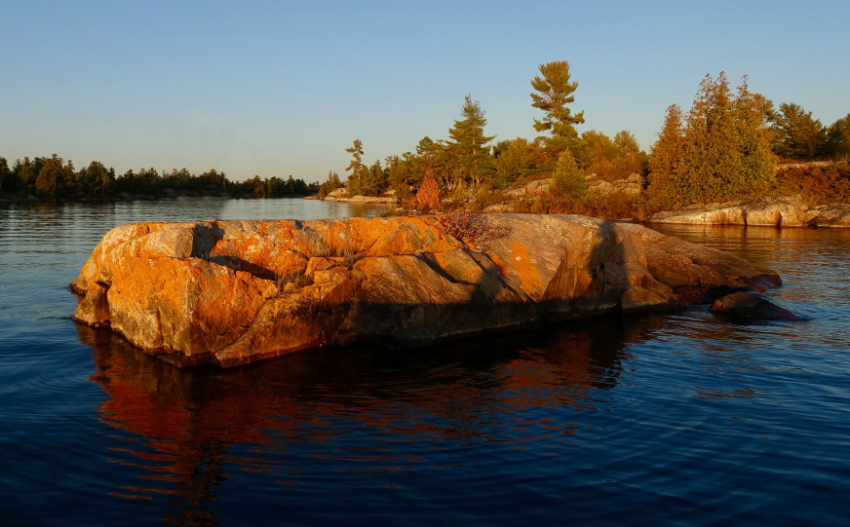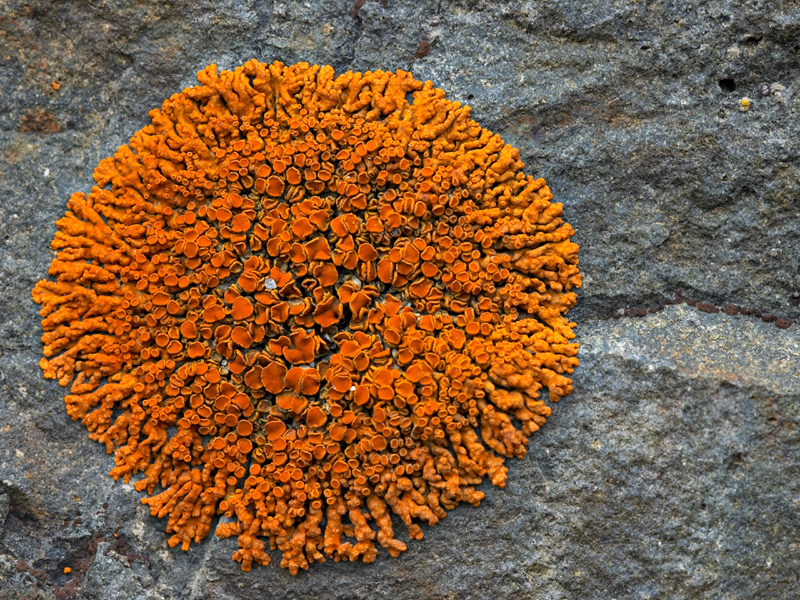
by Art Kilgour
For a long time, I’ve wondered about the bright orange lichen that flourishes on certain rocks near open water in Bayfield-Nares, but rarely inland. (The more common lichens we see on exposed rocks everywhere are dull grey, silver, yellow, pale green or white.)
I was curious about two things. First, what exactly is lichen? I’d heard it was a complex organism, not a plant but not a fungus either. And second, the real mystery: why is the bright orange lichen so picky about where it grows in our archipelago? I only see it on west-facing rocks near the open, almost always beside the water.
I consulted an amateur naturalist and blogger named Ian Chadwick of Collingwood, who I discovered online. He was curious about the orange lichen as well, which he said has “colonized” the rocks along the town’s waterfront. He in turn directed me to an expert, Dr. Troy McMullin, a lichenologist at the Canadian Museum of Nature in Ottawa.
Between the two of them, the story of lichens gradually emerged, and I finally found the answer to the orange mystery.
What is lichen?
Chadwick writes, “Among the things that fascinate me about lichens is that they are not a single organism, but are symbionts—composite organisms that include fungi and single-celled algae (or less commonly, cyanobacteria).”
The fungus part of lichens provides their structure (on trees, they can even be mistaken for mushrooms). The algae part converts sunlight to food energy. Chadwick says that lichens have been called “fungi that discovered agriculture.” But if fungi are the farmers, the microscopic algae also benefit from the relationship, by getting water and minerals from the larger, more visible fungus.
And crucially, lichen can live where neither of the partners could survive alone. As well, a lichen is neither a fungus like a mushroom nor a vascular plant like grass, flowers, and trees (plants that transport water and energy within themselves). They are their own complex organism, a little like sea corals. Somewhat confusingly, scientists classify and name lichen according to their fungus species, not by their algae or cyanobacteria components.
Dr. McMullin further refined this story for me. He writes in his field guide Common Lichens of Northeastern North America that, “the word lichen is derived from the Greek word for tree moss. Lichens, however, can be found on many [surfaces] other than trees, such as dead wood, rocks and soil.”
Lichens grow slowly, advancing as little as 1 mm per year. They don’t have roots like vascular plants. And crucially, they don’t feed on the surfaces they’re attached to, but rather get their nutrients from air particles and water. Their porous upper surface needs to be wet before the lichen’s algae or cyanobacteria (which live below the surface) can photosynthesize food within the organism. (Don’t even ask about reproduction—too complicated to explain here!)
About 19,500 lichen species are known to science, growing all over the world, including very inhospitable environments like Antarctica.

The orange mystery
I sent photos of the orange lichen in Bayfield Inlet (like the one above) to Ian Chadwick. He immediately suspected it was the same as his Collingwood waterfront lichen, even though the photo wasn’t a close-up.
He provided two names for it: an informal one (Elegant sunburst lichen) and a Latin one (Xanthoria elegans). I viewed detailed photos online that showed the lichen in a circular shape (sunburst!). I suspected that our Xanthoria patches in Bayfield were just multiple organisms growing together into larger mats of brilliant colour.
Next, I forwarded the photos to my Ottawa expert, Troy McMullin, along with a query: “Why does the lichen prefer these locations? Is it because of moisture, wind, or even light?”
His reply took me by surprise: “Xanthoria elegans (now called Rusavskia elegans) is a nitrophile [a nitrogen lover]. It is common at sites that are regularly fertilized by birds.”
What? Sunburst lichen is attracted to the nitrogen in bird poop?
So, it’s not that orange lichen prefers these locations. Rather, birds like to hang out there, watching the sun set and fertilizing the rocks. And their droppings are a handy meal for the Sunburst lichen, which would otherwise have to get nitrogen from the atmosphere, a trickier conversion. Well, that’s a complicated answer!
Finally, I learned from another source (Lichens of the North Woods, by Joe Walewski) that:
All hail the mighty Rusavskia elegans! It’s a regal and hardy lichen that gives us something pretty to look at when we go shoal hopping or picnicking at the open and is well integrated into our complex local ecosystems.